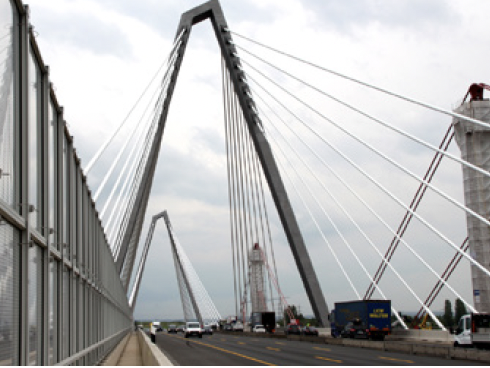Special Bearings and Noise Reduction for Leverkusen
Leverkusen. Special restraints for the bearings and noise reduction on the
expansion joints – MAURER supplied high-quality special elements for the
first new section of the bridge over the Rhine in Leverkusen.
The previous Leverkusen Rhine bridge on the A1 motorway had been in opera-
tion since 1965, and due to cracks in the steel loadbearing structure, could only
be used by vehicles of up to 3.5 tonnes at a maximum of 60 km/h since 2014.
This caused major traffic problems in the region, as delivery traffic had to use
other bridges.
Since February 2024, the problem has been partially alleviated. The first cable-
stayed bridge – of two directional lanes – of the replacement construction was
inaugurated and now carries the entire traffic of 150,000 vehicles per day. The
bridge is a total of 1,068.5 m long (main bridge 690 m) and has two distinctive
A-shaped pylons. The width of over 33 m is currently used for three narrowed
lanes in each direction towards Koblenz and towards Dortmund. In future, it is
designed for four lanes, two access and exit ramps plus hard shoulder and a
3.25-metre-wide cycle path.
The old bridge with the reddish stays is currently being dismantled. From 2025,
the second parallel section of the bridge is planned to be built and inauguration
is scheduled for 2027.
Bridge bearing system with special functions
Both of the new, separated bridge structures consist of a main span and an
approach bridge on the left bank of the Rhine. The main span with a steel
superstructure as well as the approach bridge in a concrete box girder variant
are supported by modern bridge bearings with special functions.
MAURER supplied and supplies 44 MSM ® spherical bearings for each of the two
bridges.
Spherical bearings are sliding bearings that can accommodate arbitrary rota-
tions in all directions without noticeable resistance and transfer them to the
substructure with virtually no restraint. The main span as a cable-stayed bridge
transfers an enormous superimposed load of approximately 100,000 kN to
the MSM ® spherical bearings below the pylon. The patented MSM ® – MAURER
Sliding Material – proves its worth here. In contrast to alternatives such as
PTFE, it is PFAS-free. Additionally, MSM® has a much longer service life (more
than 50 years) and twice the compressive strength. The bearings can therefore
be built smaller.
A special construction method enables part of the bridge bearings to be tem-
porarily restrained in the horizontal direction and monitored and gradually
released and loosened as required. This increases work safety during the con-
struction process and protects the adjacent components against uncontrolled
impact load. The approach bridges used these temporary restraints to imple-
ment a shifting fixed point for the construction of the bridge; the main spans
activated the restraints when bearings needed to be replaced. MAURER Project
Manager, Dirk Wilming, explains: “Such smart bearing systems are exemplary
and make life easier on site.”
Low-noise expansion joints
The three expansion joints also supplied by MAURER are exceptional due to their
length alone. The largest, an XLS 800, is 36.3 m long and has 7 profiles as well
as 2 edge profiles. It is installed in axis 10 at the beginning of the main span. The
other two expansion joints bridge the end of the main span and the end of the
approach bridge.
The expansion joints compensate for the longitudinal movements of the bridge.
Regarding design, these are so-called swivel joist expansion joints. Their special
feature is that they allow movement in all directions: Displacements transverse,
longitudinal and vertical to the direction of traffic as well as any kind of rotations.
All three expansion joints are noise reduced. Specially profiled rhombs welded
on top reduce the noise level by 30 to 50 percent. Welded on top, as this lasts
significantly longer than screwed elements, which can loosen due to the con-
tinual crossings.


